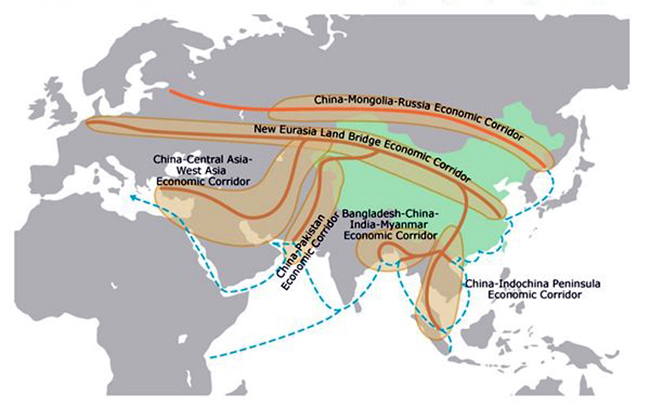More than two thousand years ago, China’s Han Dynasty launched the Silk Road, a sprawling network of commerce that linked South and Central Asia with the Middle East and Europe. Lately, the Belt and Road initiative (B&R) was raised by Chinese President Xi Jinping in September and October 2013. The B&R will extend from the Chinese mainland to Europe and includes about 65 per cent of the world’s population living in more than 60 countries across Asia, Europe and Africa. This will cover 30 per cent of the world’s GDP and about a quarter of all the goods and services the world moves.
The Belt and Road has two parts: the “belt” is the physical road. Essentially, the “belt” includes countries situated on the original Silk Road through Central Asia, West Asia, the Middle East, and Europe. However, “road” is actually the maritime Silk Road, also known which is highly ambitious. So, the Belt and Road refers to the land-based “Silk Road Economic Belt” and the ocean-based “21st Century Maritime Silk Road”.
The initiative calls for the integration of the region into a cohesive economic area through policy coordination, infrastructure development, investment and trade facilitation, financial integration, and cultural and social exchange.
To talk about funding side, the Asian Infrastructure Investment Bank (AIIB), a China-led international financial institution, came into being to offer finance to infrastructure projects as part of China’s Silk Road initiative, with a focus on bolstering links across Asia, the Middle East, Africa and Europe. Chinese President announced its creation during a tour of Southeast Asia in October 2013. The AIIB’s subscribed capital of $100 billion could support lending operations of between $200-500 billion, depending on how the institution raises funding and operates its lending business. It is worth saying that this year, the AIIB added 13 new members, bringing its total membership up to 70. Afghanistan, Belgium, Ireland, Peru, Fuji, Hungary, Armenia, Ethiopia, the Republic of Sudan, and Venezuela are included among the 13 applicants to the bank who received approval.
The creation of the AIIB follows other, similar Chinese-led initiatives to influence the global multilateral financial architecture. For instance, in July 2014, Brazil, Russia, India, China and South Africa – known as the BRICS countries – announced plans to create both a new multilateral development bank and a shared currency reserve pool. This body, dubbed the New Development Bank (NDB), will have a capital of $50 billion, with 20% contributed by China. Headquartered in Shanghai, the NDB has a similar mandate to the AIIB, namely to support infrastructure and sustainable development projects in BRICS countries and other emerging markets (EMs).
Moreover, the Silk Road Fund also came into being to foster increased investment in countries along the One Belt, One Road. Hosting the Belt and Road Forum in May, Chinese President Xi pledged a major funding boost to the new Silk Road, including an extra 100 billion yuan ($14.50 billion) into the existing Silk Road Fund, 380 billion yuan in loans from two policy banks and 60 billion yuan in aid to developing countries and international bodies in countries along the new trade routes.
“China is willing to share its development experience with all countries. We will not interfere in other countries’ internal affairs. We will not export our system of society and development model, and even more will not impose our views on others,” Xi is cited as saying.
In the past decade and a half, Kabul has pushed for regional integration. In the period since 1980, it has tried to get full membership or observer status in regional economic, security and political organizations such as the South Asian Association for Regional Cooperation (SAARC), Central Asia Regional Cooperation Program (CAREC), Conference on Interaction and Confidence Building Measures in Asia (CICA), Asia Cooperation Dialogue (ACD), and Shanghai Cooperation Organization (SCO) and most recently in the Asian Infrastructure Investment Bank (AIIB).
“The Belt and Road Initiative has five major roles, to promote policy coordination, facilitate connectivity, promote unimpeded trade and promote financial inauguration and more people-to-people advance in these areas.”
No doubt, Afghanistan will be one of the beneficiaries of the B&R and similar activities. China is Afghanistan’s supportive neighbor which seeks to cooperate not only in financial activities but also regarding peace and stability. The Quadrilateral Coordination Group (QCG) reveal this fact.
Home » Opinion » The Constructive Role of the Belt and Road
The Constructive Role of the Belt and Road
| Hujjatullah Zia

